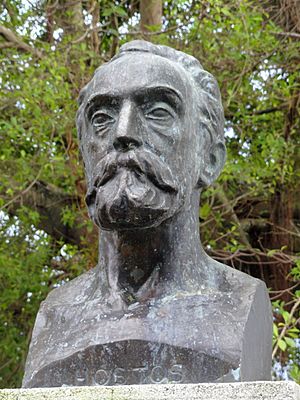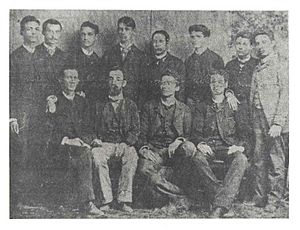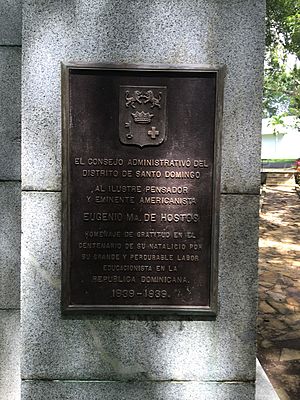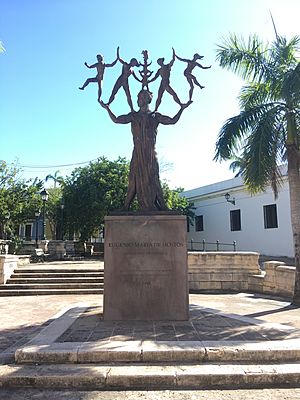Eugenio María de Hostos facts for kids
Quick facts for kids
Eugenio María de Hostos
|
|
|---|---|

Portrait by Francisco Oller
|
|
| Born | Eugenio María de Hostos y de Bonilla January 11, 1839 Mayagüez, Puerto Rico |
| Died | August 11, 1903 (aged 64) Santo Domingo, Dominican Republic |
| Resting place | National Pantheon of the Dominican Republic |
| Occupation |
|
| Nationality | Puerto Rican |
| Literary movement | Puerto Rican independence |
| Notable works | La Peregrinación de Bayoán |
| Spouse | Belinda Otilia de Ayala y Quintana |
| Children | Eugenio Carlos, Luisa Amelia, Bayoán Lautaro, Adolfo Jose, Filipo Luis Duarte, María Angelina |
Eugenio María de Hostos y de Bonilla (born January 11, 1839 – died August 11, 1903) was a very important person from Puerto Rico. People called him El Gran Ciudadano de las Américas, which means "The Great Citizen of the Americas." He was an educator, philosopher, lawyer, and sociologist. He also wrote books and fought for Puerto Rico's freedom.
Contents
Early Life and Education
Eugenio María de Hostos was born in Mayagüez, Puerto Rico, on January 11, 1839. His family was quite wealthy. When he was young, he went to school in San Juan, the capital city.
In 1852, his family sent him to Bilbao, Spain, to continue his studies. He finished high school there. Later, in 1857, he went to the Complutense University of Madrid. He studied law, philosophy, and literature. While he was a student, he became very interested in politics. In 1863, he published his most famous book, La Peregrinación de Bayoán.
In 1869, Spain made a new constitution. But they did not give Puerto Rico its freedom. Because of this, Hostos decided to leave Spain and move to the United States.
Fighting for Freedom
Hostos stayed in the United States for about a year. During this time, he joined a group called the Cuban Revolutionary Committee. He also became the editor of a newspaper called La Revolución.
Hostos had a big dream: he wanted Puerto Rico, the Dominican Republic, and Cuba to join together. He called this idea the Antillean Confederation. Other Puerto Rican leaders, like Ramón Emeterio Betances, liked this idea too. However, Hostos was sad that many people in Puerto Rico and Cuba wanted to be free from Spain but preferred to join the United States instead of becoming truly independent.
To share his ideas, Hostos traveled a lot. He visited many countries, including France, Colombia, Peru, Chile, Argentina, Brazil, Venezuela, the Dominican Republic, and Cuba. He wanted to spread the message of independence for Puerto Rico and Cuba.
A Champion of Education
Hostos spent a year in Lima, Peru, from 1870 to 1871. There, he helped improve the country's schools. He also spoke out against the unfair treatment of Chinese people living in Peru.
After Peru, he moved to Chile for two years. He taught at the University of Chile. He gave an important speech called "The Scientific Education of Women." In this speech, he argued that women should be allowed to study in colleges. Soon after, Chile became one of the first countries to let women into its universities.
In 1873, Hostos went to Argentina. He suggested building a railroad system to connect Argentina and Chile. His idea was accepted, and the first train was even named after him!
In 1875, Hostos visited the Dominican Republic. He came up with the idea of creating a Normal School, which is a college for training teachers. He brought new and better ways of teaching. Some people from the local Catholic Church disagreed with him. This was because Hostos believed that schools should not teach religion. But he always responded calmly and thoughtfully to their criticisms.
In 1877, Hostos married Belinda Otilia de Ayala Quintana in Venezuela. They had five children together. In 1879, he returned to the Dominican Republic. In 1880, the first Normal School opened, and Hostos became its director. He also helped start another Normal School in the city of Santiago de los Caballeros.
Hostos and his family moved back to Chile in 1889. He led schools there and taught law at the University of Chile.
His Last Years and Legacy
Hostos returned to the United States in 1898. In 1900, he moved with his family to Santo Domingo, Dominican Republic. In his final years, he continued to work for the freedom of Puerto Rico and Cuba. He had hoped Puerto Rico would become independent after the Spanish–American War. But he was disappointed when the United States made the island a colony instead.
In the Dominican Republic, Hostos kept working to improve schools and railroads. He wrote many essays about social science, like psychology and law. He is known as one of the first sociologists in Latin America. He was also a strong supporter of women's rights.
Eugenio María de Hostos passed away on August 11, 1903, in Santo Domingo. He was 64 years old. He is buried in the National Pantheon of the Dominican Republic. Hostos wished for his body to stay in the Dominican Republic until Puerto Rico becomes fully independent. Only then does he want to be buried in his homeland.
Honoring a Great Mind

In 1938, a meeting in Lima, Peru, honored Hostos. They called him "Citizen of the Americas and Teacher of the Youth." Puerto Rico celebrates his birthday as an official holiday every January. There is also a monument for him in Spain.
A town in the Dominican Republic, in Duarte Province, is named after him.
Statues and Memorials
Many statues and monuments honor Hostos in Puerto Rico:
- A sculpture by Tomás Batista is now in front of the University of Puerto Rico at Mayagüez.
- Another sculpture by José Buscaglia Guillermety is at the University of Puerto Rico, Río Piedras Campus in San Juan.
- A 1998 sculpture stands in Plaza de la Beneficencia in Old San Juan.
Schools Named After Him
Many places are named after Eugenio María de Hostos:
- In his hometown of Mayagüez, Puerto Rico, there is a cultural center and museum near where he was born.
- Mayagüez also has a High School (since 1954), a Highway (since 1961), and the Eugenio María de Hostos Airport (since 1986) named in his honor.
- In 1970, the City University of New York opened Hostos Community College in the South Bronx. Many students start their college education there.
- The Eugenio María de Hostos School of Law was started in Mayagüez, Puerto Rico, in 1995. This law school aims to teach lawyers who care about their communities.
- There is a middle school in Brooklyn, New York (I.S 318) and a Pre-K/Kindergarten school in Union City, New Jersey named for him.
- The Eugenio María de Hostos Microsociety School, an elementary school in Yonkers, New York, is also named after him.
- The Eugenio María de Hostos Bilingual Charter School in Philadelphia, Pennsylvania, is a K-8 school named in his honor.
- The City of New York also named a playground after him.
Online Resources
The Miguel Cervantes Virtual Library of Spain has a special section on its website dedicated to Eugenio María de Hostos. His writings were put online in 2019 by the National Foundation of Popular Culture of Puerto Rico.
His Important Writings
Here are some of the books and essays he wrote:
- "La Peregrinación de Bayoán" (1863)
- "Las doctrinas y los hombres" (1866)
- "El día de América"
- "Ayacucho" (1870)
- "El cholo" (1870)
- "La educación científica de la mujer" (1873)
- "Lecciones de derecho constitucional. Santo Domingo: Cuna de América" (1887)
- "Moral Social" (1888)
- "Geografía evolutiva" (1895)
See also
 In Spanish: Eugenio María de Hostos para niños
In Spanish: Eugenio María de Hostos para niños
- List of Puerto Rican writers
- List of Puerto Ricans
- Puerto Rican literature
- Caribbean literature





